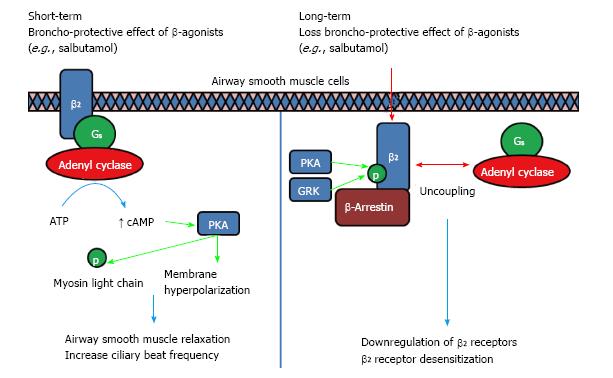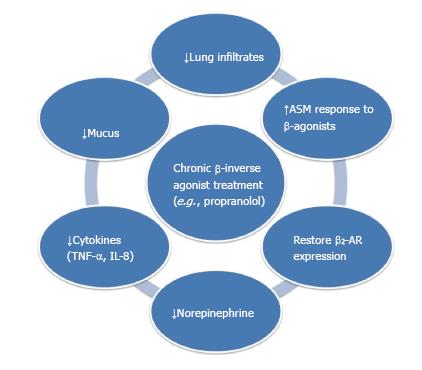Copyright
©The Author(s) 2015.
World J Respirol. Nov 28, 2015; 5(3): 199-206
Published online Nov 28, 2015. doi: 10.5320/wjr.v5.i3.199
Published online Nov 28, 2015. doi: 10.5320/wjr.v5.i3.199
Figure 1 Long-term usage of β-agonists will result in a loss of Broncho-Protective Effect where β-adrenoceptors desensitization occurs.
Broncho-Protective Effect is conferred when β-agonist binds to β2-AR, activating adenyl cyclase through Gαs, leading to an increase in cAMP levels. The surge in cAMP in turn activates PKA which phosphorylates myosin light chain to inhibit contraction. PKA also activates K+ channels, inducing membrane hyperpolarization which counteracts electrical excitation leading to contraction. Chronic use of β-agonist will lead to a loss of this Broncho-Protective Effect due to the uncoupling of Gαs from β2-AR, phosphorylation by PKA/GRK and the binding of β-arrestin which leads to internalization, downregulation and desensitization towards β-agonist[15,27,28]. PKA: Protein kinase A; GRK: G-protein receptor kinases; AR: Adrenoceptors.
Figure 2 Potential therapeutic benefits by chronic β-blocker usage in obstructive airway diseases observed in animal and clinical studies[12,40,46,47,64,65].
AR: Adrenoceptors; TNF: Tumor necrosis factor; IL: Interlukin.
Figure 3 Acute and chronic inverse agonist treatment in obstructive airway diseases.
It was shown in cell and animal models that acute treatment of β-blockers induced a partial agonist response that led to an increase in MUC5AC production viaβ-arrestin2 which serves as a multi-protein scaffold, activating ERK1/2 and p38 mitogen-activated protein kinase (MAPK), resulting in mucus hypersecretion and increased airway resistance response to methacholine. However, chronic treatment of β-blockers led to a reduction in mucus secretion, decreased airway hyperresponsiveness and reduced inflammation, through the non-canonical β-arrestin2-mediated signaling induced by inverse agonism of β2-adrenoceptors[46]. The differential response could be due to the binding of ligand to a shallower secondary binding site exposed only when an adequate conformational state is obtained as proposed by Soriano-Ursúa et al[44], however more work need to be done to validate the mechanism.
- Citation: Tan DW, Wong JL, Tie ST, Abisheganaden JA, Lim AY, Wong WF. β2-adrenoceptor in obstructive airway diseases: Agonism, antagonism or both? World J Respirol 2015; 5(3): 199-206
- URL: https://www.wjgnet.com/2218-6255/full/v5/i3/199.htm
- DOI: https://dx.doi.org/10.5320/wjr.v5.i3.199











